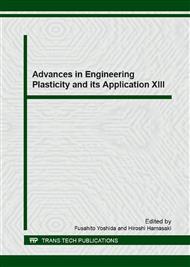p.339
p.345
p.351
p.359
p.366
p.372
p.378
p.383
p.389
Evaluation of Very High Cycle Fatigue Properties of β-Titanium Alloy by Using an Ultrasonic Tensile-Compressive Fatigue Testing Machine
Abstract:
β-titanium alloy has been developed recently because β-titanium alloy has better cold workability, proof stress, and tensile strength. In order to use β-titanium alloy for automobile parts subject to cyclic loading, very high cycle fatigue properties of β-titanium alloy should be investigated. In this study, very high cycle fatigue properties of β-titanium alloy Ti-22V-4Al were evaluated by using an ultrasonic fatigue testing method, which allows us to reduce a fatigue testing period to 1/100 − 1/1000 of that by using conventional testing methods. An S-N diagram and fracture morphology of Ti-22V-4Al in the very high cycle region were investigated. Fatigue failure was observed and subsurface fracture occurred in the very high cycle region.
Info:
Periodical:
Pages:
366-371
Citation:
Online since:
December 2016
Price:
Сopyright:
© 2017 Trans Tech Publications Ltd. All Rights Reserved
Share:
Citation:


